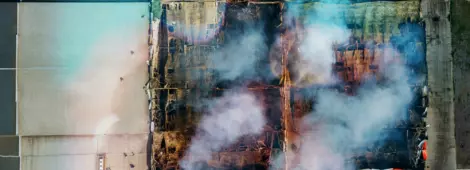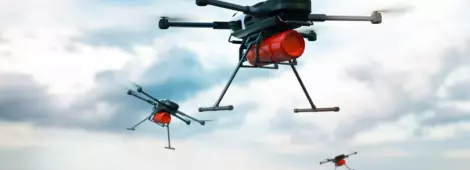
Dispersed Explosion Investigations – What Came First, the Fire or the Bang?
by Gareth Williams, B.Biotech (Hons), Dip. Forensic Investigation, IAAI-CFI
Investigating an explosive incident, be it a deliberate criminal act or an accidental fuel/air explosion, is a complicated, technical and multi-faceted undertaking.
There are different types of explosions — and dispersed explosions are some of the most common and complex to investigate. These types of explosions typically involve gas or dust. The size, nature and location of a dispersed explosion will dictate the extent of resources required to investigate and recover. It is challenging to determine what came first in dispersed explosions — did a fire set off the explosion or did a fire result from the explosion? In some cases, it is readily apparent what came first from witness information, CCTV footage or physical evidence. But in most circumstances, it is not.
Why is it so essential to determine whether fire or explosion came first? Apart from the apparent reason of wanting to know the truth to satisfy our enquiring forensically-focused minds, determining whether fire caused an explosion or whether the blast resulted in a fire is crucial for reasons including:
- Determining the sequence of events;
- Root cause analysis;
- Public interest;
- Prevention of a similar incident in the future;
- Recovery or repudiation prospects;
- Pursuing or defending a claim.
As with any fire and explosion investigation, investigators must apply the scientific method. The scene may well be chaotic, especially if the investigator is on-site relatively soon after the event. Information gathering in the early stages is imperative and will require a coordinated logical methodology.
Witness accounts of any sounds they heard, things they saw, or odors they detected may be unreliable or inaccurate or deliberately misleading in some cases.
How much a scene was disturbed before an investigation will determine how to inspect physical evidence and conclusions reached. This disturbance could include:
- The necessary actions of first responders,
- Any inspections carried out by public service or private sector investigators at an earlier date,
- Any post-explosion structural collapse,
- The extent and duration of any burning,
- And any clean-up work that has taken place.
Determining the Sequence of Events in a Dispersed Explosion
As alluded to before, it’s not always cut-and-dry what came first. Sometimes, a scenario such as the one outlined below can complicate an investigation:
Initial Explosion → Fire → Further Explosion(s) → Secondary Fire
Other scenarios could include a dust explosion that severs a gas pipe or breaks a gas cylinder valve. This may allow an explosive gas and air mixture to develop, which could be ignited — potentially even by new ignition sources created by the explosion, like damaged electrics. Of course, the reverse situation could occur. A fire or small explosion (gas or mechanical) may result in the dispersal of dust which is then ignited, resulting in a much larger secondary explosion.
How to Approach A Dispersed Explosion Investigation
Careful observation, recording (notes, sketches, photographs, drone footage, surveys), and inspection of the physical evidence should, in most instances, allow for determination of:
- The seat of the explosion (usually a more complex task for a fuel and air explosion than a concentrated chemical or mechanical explosion);
- The location and extent of structural damage and damage to contents;
- The area and type of any explosive fragments (often mistakenly called shrapnel, in accidental explosions);
- The direction of fire spread;
- The type of fuel that was first ignited when it was in a dispersed state and caused the explosion (often self-evident depending on the nature of the structure in which the explosion has occurred, i.e., a grain silo);
- The location of explosion damage relative to where potential ignition sources were present.
The unique circumstances of each case will dictate the probability of determining the cause of the explosion. The experienced and trained investigator will base their conclusions on the totality of witness evidence, physical evidence and other sources of information, sometimes requiring specialized knowledge of particular machinery, industrial processes, chemistry or relevant regulations.
By systematically inspecting the scene, investigators increase the chance of determining whether a fire preceded or followed an explosion.
We have experienced fire and explosion investigators for any explosion cases where you require a forensic expert to provide a timely and technically excellent service. To instruct one of our forensic investigators, contact us at Instructus.uk@jensenhughes.com.

Gareth is a Senior Investigator with experience in fire and explosion investigations in many different settings. Throughout his career, he has investigated over 500 fires in the UK, Europe, Australia, the Pacific and South East Asia. These…












